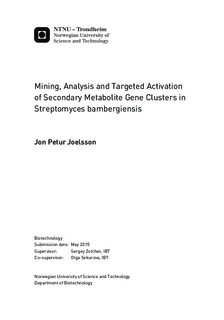Mining, Analysis and Targeted Activation of Secondary Metabolite Gene Clusters in Streptomyces bambergiensis
Abstract
The discovery of new antibiotics is one of the most urgent tasks facing scientists today. The escalating rate of resistant microbes creates a constant need for new or improved drugs. With the recent progress in genome sequencing a new world is opening up as researchers can explore bacterial antibiotic biosynthesis gene clusters that are normally silent under laboratory conditions. Waking up these silent gene clusters harbours the potential of novel drug discoveries to fight microbial infections, cancer or other major life-threatening conditions. In this work, genetic potential of Streptomyces bambergiensis, known producer of antibacterial antibiotic moenomycin, was investigated. Whole genome sequence of S. bambergiensis showed that it has, in addition to moenomycin cluster, 28 secondary metabolite biosynthetic gene clusters, including a giant polyketide synthase (PKS) gene cluster composed of 30 genes and spanning over 190 kb. The product of this gene cluster is unknown and likely not produced under laboratory conditions. First, moenomycin gene cluster was inactivated in S. bambergiensis by deletion in order to eliminate antibacterial background activity. Next, constitutive expression of the regulatory gene, a LuxR family transcriptional regulator, from the PKS gene cluster was accomplished, leading to the production of a compound with inhibitory activity against Bacillus subtilis. Preliminary analysis suggested that this may be a new compound that can be further studied as a potential antibiotic.
